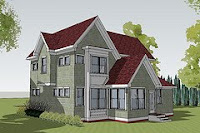 Did you know that Australians now live in houses that are double the size of those they lived in 50 years ago? Did you know that the average Australian has 6-9 people in their house during one year?
Did you know that Australians now live in houses that are double the size of those they lived in 50 years ago? Did you know that the average Australian has 6-9 people in their house during one year?We live in expensive, isolated splendour. The overseas students we meet through my husband's university ministry say that most visitors from other countries return home after years of study or work never having entered an Australian home. Most Australians live next door to people who never set foot inside their front door.
Modern suburbia eerily parallels CS Lewis' description of hell in The Great Divorce, as Ben Pfahlert pointed out during his talk on Philippians 1 at last weekend's MTS Challenge Conference Victoria. CS Lewis' words as he describes the "grey town" of hell are almost prophetic:
I seemed to be standing in a busy queue by the side of a long, mean street. ... I had been wandering for hours in similar mean streets, always in the rain and always in evening twilight. ... I never met anyone. But for the little crowd at the bus stop, the whole town seemed to be empty. ...
'It seems the deuce of a town,' I volunteered, 'and that's what I can't understand. The parts of it that I saw were so empty. Was there once a much larger population?''Not at all' said my neighbour. 'The trouble is that they're so quarrelsome. As soon as anyone arrives he settles in some street. Before he has been there twenty-four hours he quarrels with his neighbour. But before the week is over he's quarrelled so badly that he decides to move. Very likely he finds the next street empty because all the people there have quarrelled with their neighbours - and moved. If so, he settles in. If by any chance the street is full, he goes further. But even if he stays, it makes no odds. He's sure to have another quarrel pretty soon, and then he'll move on again. Finally he'll move right out to the edge of town and build a new house. ...
'They've been moving on and on. Getting further apart. ... Astronomical distances. There's a bit of rising ground near where I live and a chap has a telescope. You can see the lights of the inhabited houses, where those old ones live, millions of miles away. Millions of miles from us and from one another. Every now and then they move further still.'
As the bus in the story rises in the air, and the grey town spreads out below from horizon to horizon, it's modern suburbia I'm seeing from an aeroplane window in my mind's eye.
It should be different for us as Christians - but is it? My friend and her husband, who work with overseas students, aim to have 100 unbelievers in their home every year! Her example and Ben's talk challenged me to choose compassion over control, comfort and convenience, and to work harder at overcoming the splendid isolation of the modern home.
brenner_ron and icopythat from flickr
27/8/2009
2 comments:
Hi Jean, I'm intrigued by your comment that "the average Australian has 6-9 people in their house during one year". Are you referring to having people around for a meal, or those who stay overnight in the house, or the number who live there over a year?? I would be really interested if you could point me to any references for this figure!
Thanks! Fiona McLean
I'm so sorry, Fiona, I can't remember now where that figure came from (I'll think about it) and I also wondered exactly what it meant! Maybe we could google it??
Post a Comment